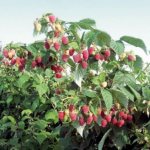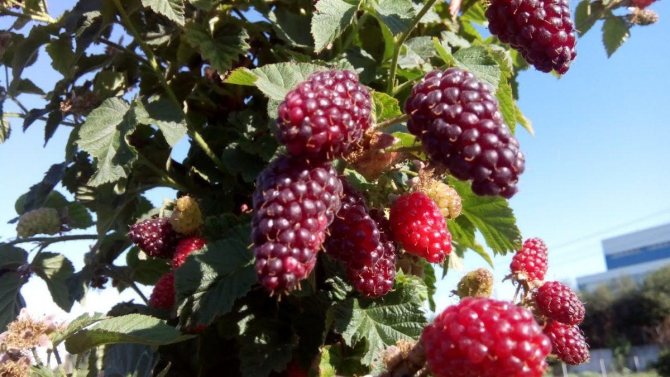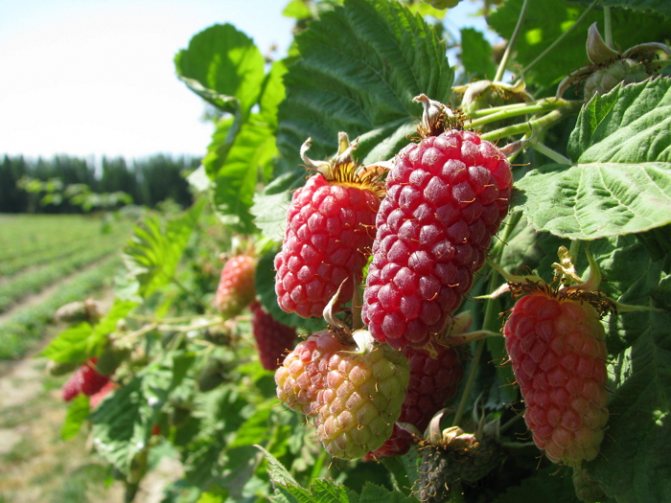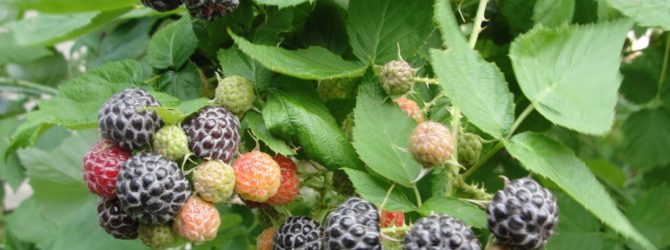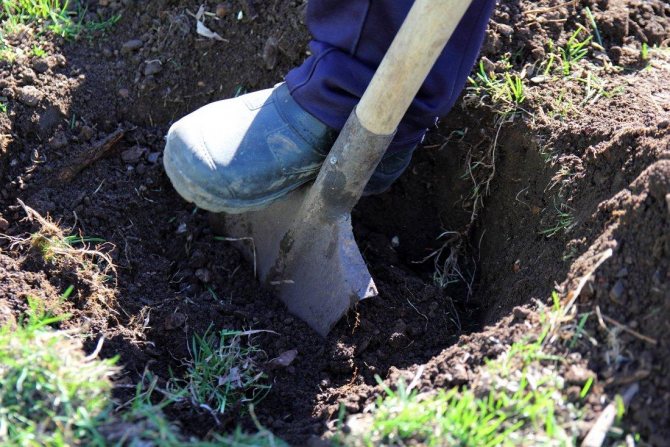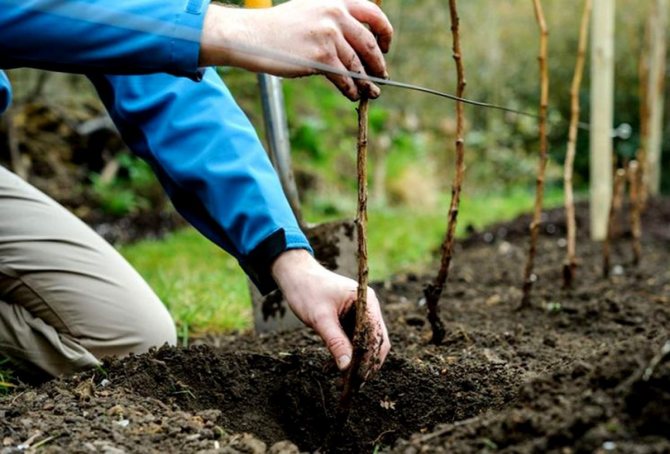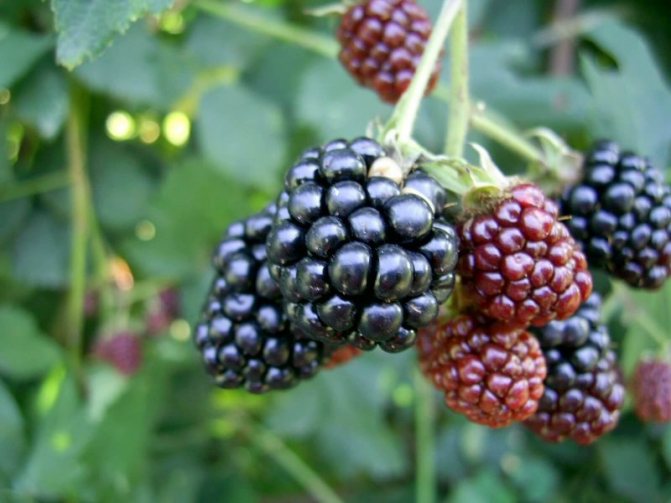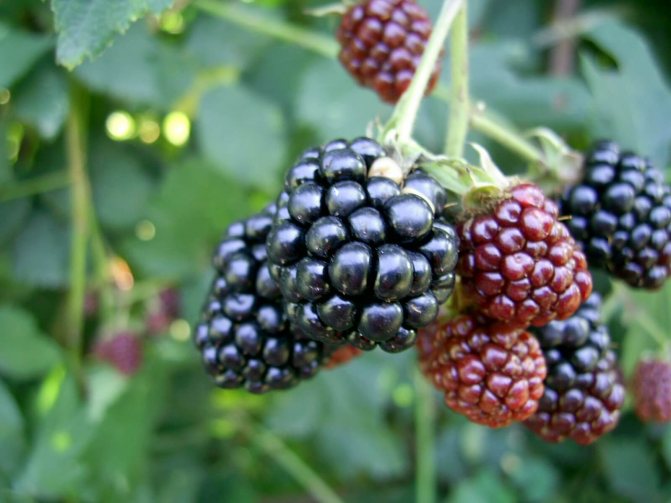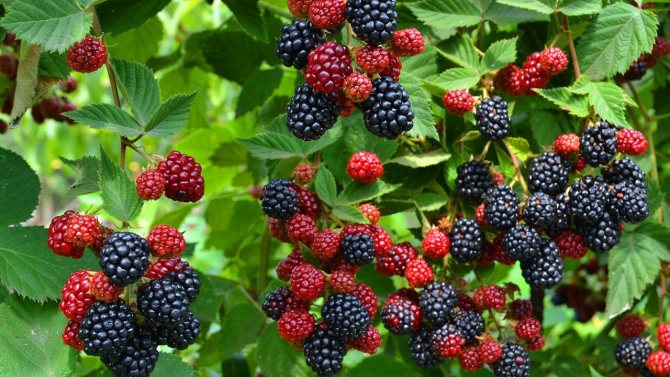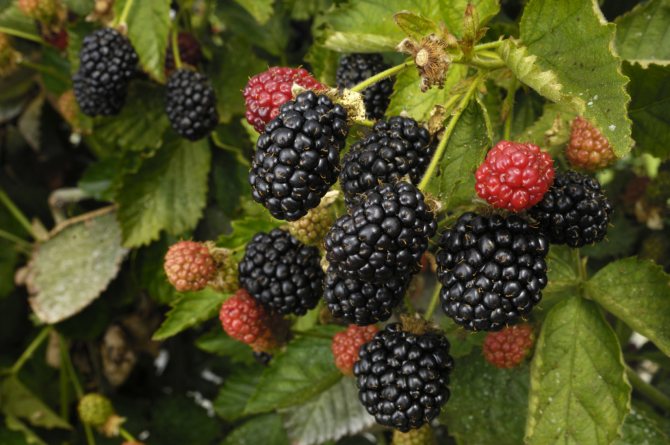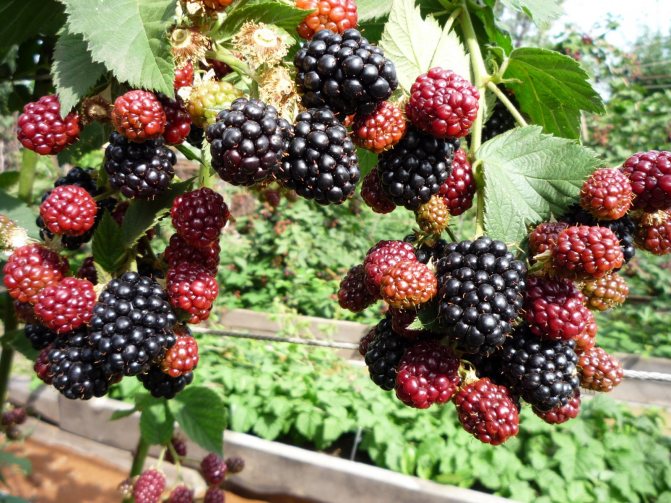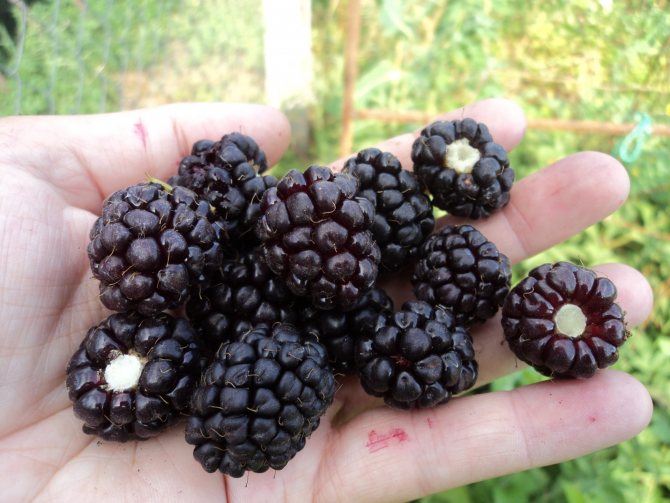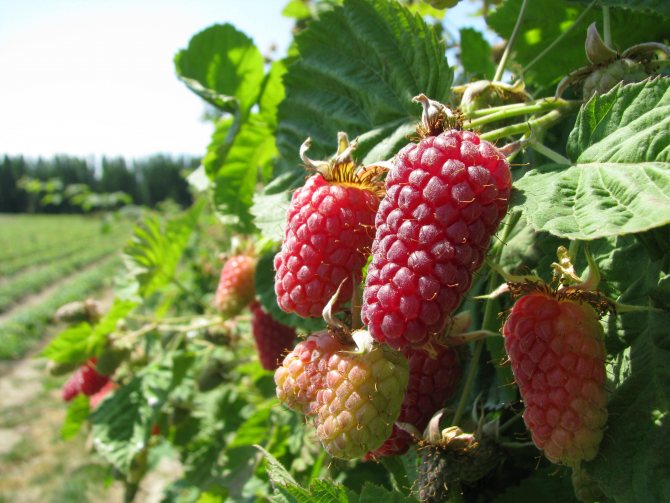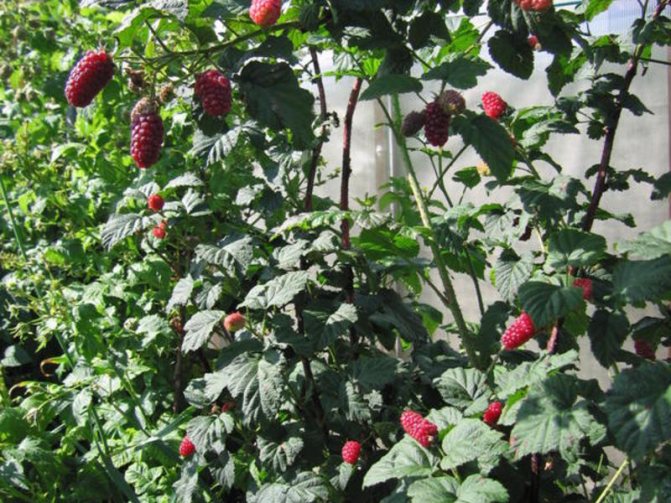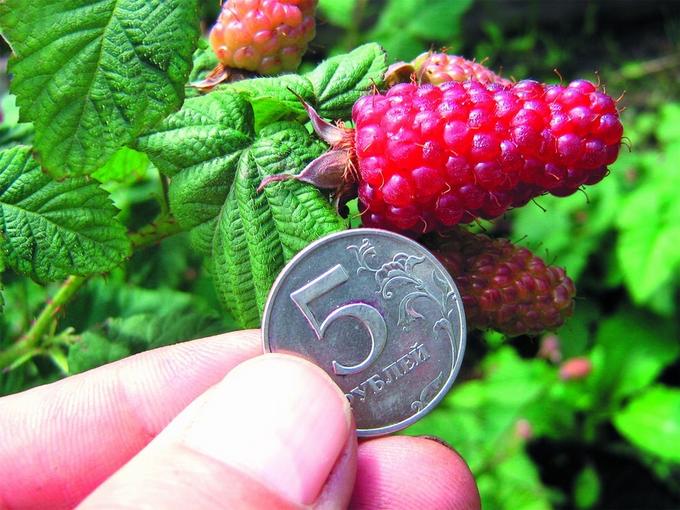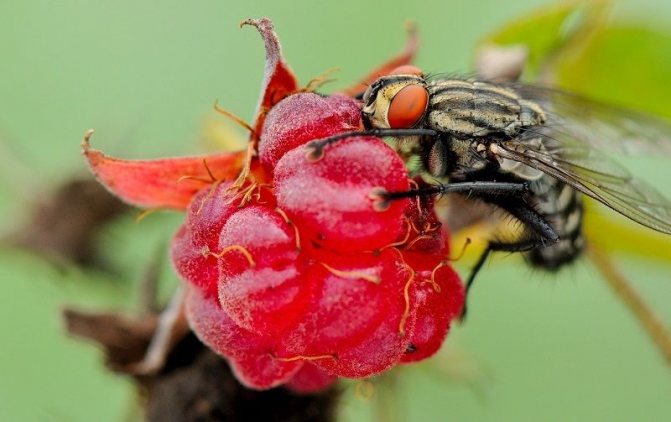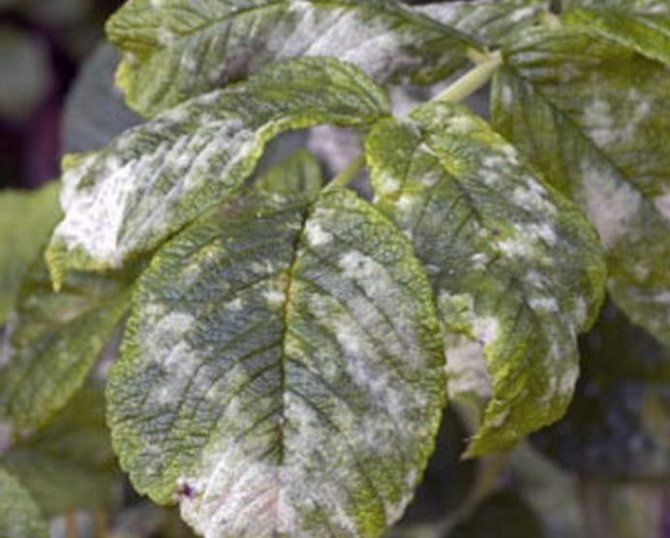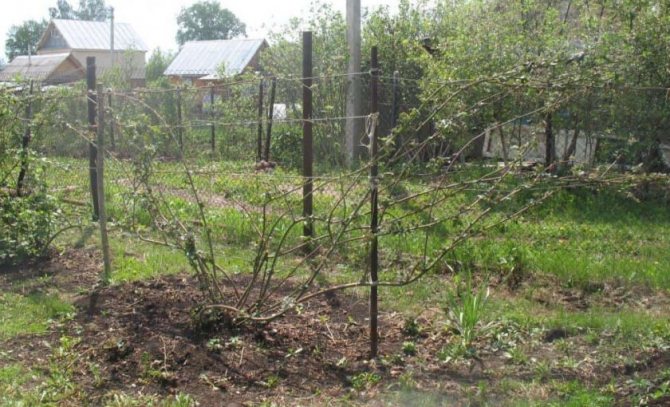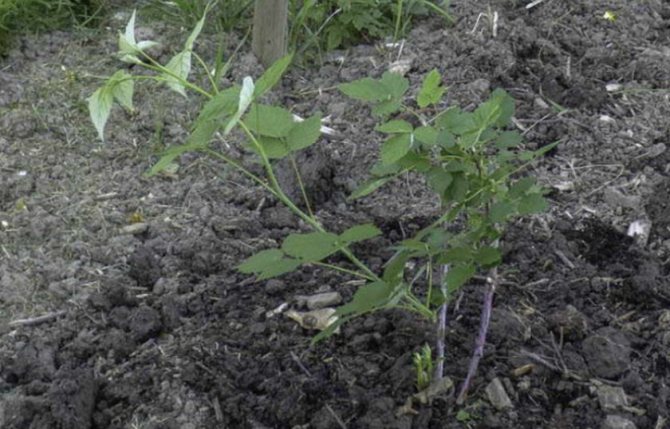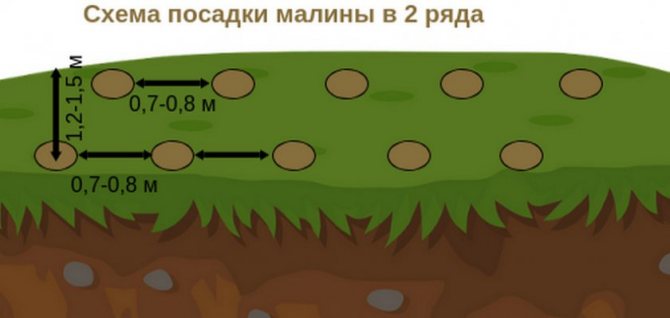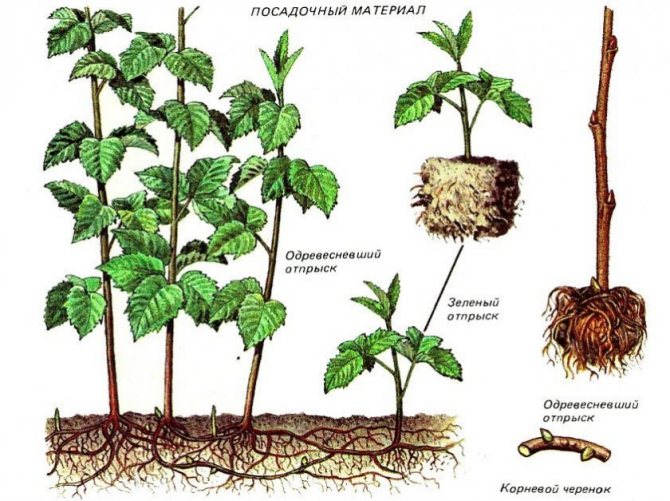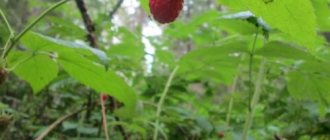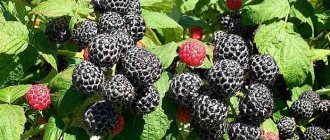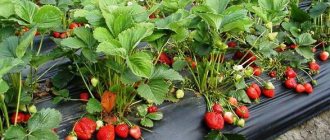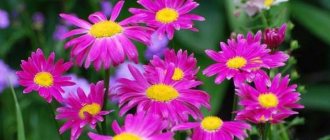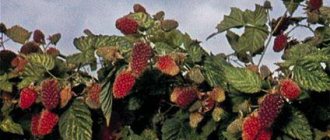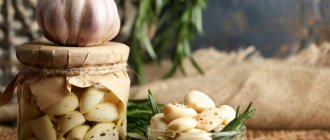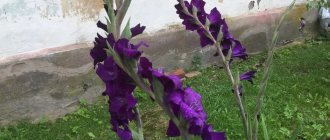- 3.1 Soil requirement and fertilization
- 6.1 There are the following methods of vegetative propagation of the ezmalina:
Ezhemalina is an increasingly popular hybrid that can become a real discovery for an amateur gardener. The berries of this plant have a great sour-sweet taste, they contain a whole range of nutrients and vitamins. This plant is unpretentious, gives a good harvest, and its bushes blooming with large white inflorescences are used for decorative purposes.
The Yezemalina phenomenon (video)
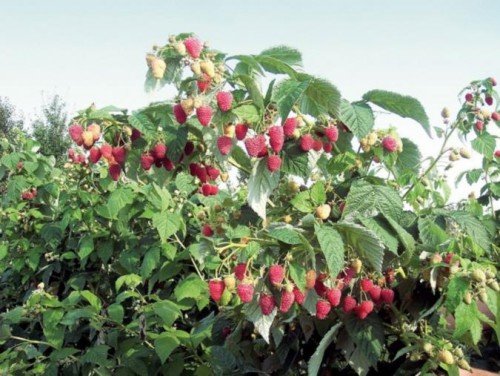
Yezhemalina bushes grow quickly and need a competent garter, otherwise they can quickly fill the site
If we compare ezemalina with traditional raspberries, it turns out that the first will give odds to the good old favorite of gardeners in terms of yield. Juice and taste are not worth mentioning once again. Add to this a wide variety of vitamins (including vitamins B1, B2, B3, E, C, PP, K and Bg) trace elements (and here we have collected phosphorus, magnesium, manganese, copper and iron) plus carbohydrates and apple and citric acid, and get a portrait of the ideal berry grower on the site.
It is difficult to overestimate the benefits of ezemalina. To begin with, a diaphoretic broth is obtained from its leaves. Berries can be used both as a laxative and as a fixative. For the first, you need to take ripe berries, for the second - unripe. Here's an interesting point.
Ezhemalina serves to strengthen the capillaries, is an anti-inflammatory agent and helps in the fight against sclerosis, and due to the content of large amounts of calcium, it is an invaluable gift to all people suffering from joint diseases.
The need for pruning jemalina
Ezhemalina needs constant pruning for several reasons:
- Prevention of overgrowth and filling of the entire site with it due to the rapid development of the bush.
- Prevention of disease and pest attacks.
- Thinning the plant for more light and air.
- Preparation for wintering and protection of shoots.
- Giving an aesthetic look to raspberry bushes.
- Maintaining the passage between the alleys.


Jemalina berries
Note! If you do not carry out timely and thorough trimming work, then over time the plant will acquire an unkempt appearance, the yield will decrease, the berries will be crushed and become sour.
Agrotechnics
As soon as we got acquainted with the wonderful qualities of the ezemalina, it was time to find out how to keep it in the garden. Its cultivation is in many ways similar to the cultivation of common raspberries.
The place where the ezemalina grows must be protected from the northerly winds and be under the sun.
When planting this crop, manure and compost should be excluded, since they provoke shoot growth and increase yields in the first year. It is not bad if you do not want to grow jemaline for more than one season. If not, then remember that it is the abundant growth of shoots and high yields that make the plant defenseless against the winter cold. Mullein and poultry manure solutions should only be used two years after planting.
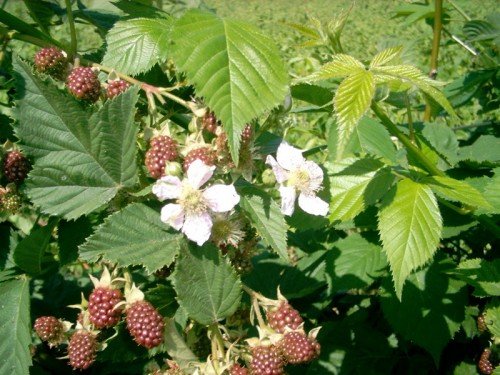

Ezhemalina gives an excellent yield and surpasses the usual raspberries in this indicator.
A distance of 0.7-1m is maintained between the bushes, and 1.5-2m between the rows. After the seedlings are planted in the ground, they are cut to 25 cm, watered and mulched. Ezhemalina is capable of growing shoots from two to four meters long, which spread along the ground and require fastening. To fix them, a trellis is pulled at a height of one and a half meter, to which the shoots are attached. For the winter, the mount is removed and insulated with peat, sawdust, straw, branches, spunbond and other materials. If the winter is snowy, then there is no need to cover.
Reproduction of ezemalina at home
Reproduction is carried out in several ways. The easiest one is to propagate by basal processes. To do this, the roots of the mother plant should be dug up and carefully divided into processes of 8-15 cm. Each root segment is transplanted into previously prepared holes or furrows, watered.
Note! Such manipulations can be carried out only if the bush is strong and healthy.
The second way to propagate a culture is by cuttings. Planting material is prepared in spring, for this, cuttings about 10 cm long are cut from the mother plant, with the obligatory presence of buds. Rooting is carried out in containers with rich nutrient soil, carrying out regular irrigation. After the roots appear, the cuttings are transferred to a permanent place. This can be done in autumn or spring.
Reproduction by layering involves the following procedure:
- Next to the bush, a furrow is dug 25 cm deep.
- In August, one of the branches of the mother plant is bent to the ground and buried in the furrow. In the spring, the new plant will take root.
- After that, it should be separated from the mother bush, carefully dug up and transplanted.
Note! Each gardener can independently choose the way due to which the yogurt will multiply and bring an even richer harvest.
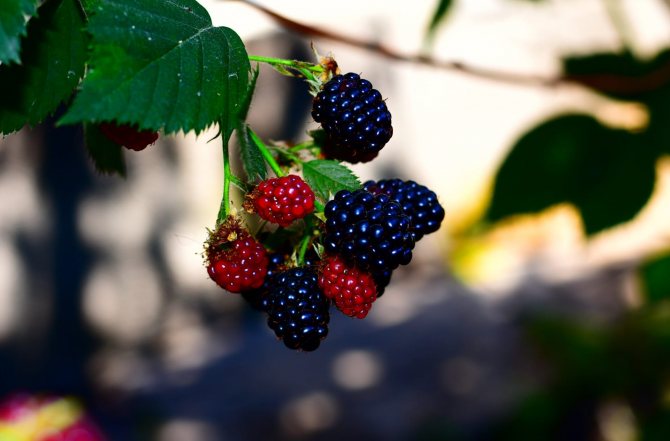

Yezhemalina bushes will adorn any garden plot
Pruning and shaping
To increase crop yields, the bushes must be pruned annually. The first period begins at the end of May - the first half of June. One-meter shoots are pruned by 10-15cm. Then these shoots will branch better. The second period begins in the second half of summer after fruiting. At this time, the fruiting shoots are cut out entirely. It will not be superfluous to thin out the bush, leaving only 8-9 shoots on it. In the spring, you will need to carry out another thinning and leave 4-6 of the strongest shoots.
You can remove the harvest from the bushes in the second year of their life.
Secrets of caring for ezemalina
Like all crops, ezemalina has its own secrets to successful cultivation. We will definitely get to know them.
High-quality mulching is the key to good growth. At the junction of April-May, the earth under the bushes of the Yazhmaliny is covered with corrugated cardboard, which is used to make boxes. On top of it is poured a mixture of rotten sawdust, ash, dry mullein and weeds obtained as a result of weeding. All this forms a layer of 8-15 cm. In addition to the fact that it is a good protection against weeds, such mulch rotting in a year and turns into an excellent fertilizer.
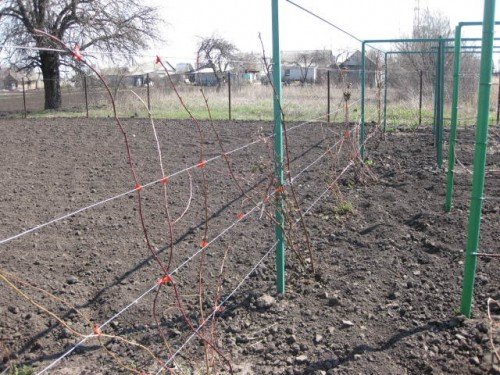

The garter is carried out on a single-plane trellis, and the fruiting branches are fixed on the upper rows of stretched nylon fishing line
Another secret is the garter belt. For this, a single-plane trellis with a height of 2.2 m is placed, a thick nylon line is stretched between the supports in five layers. Those shoots that will bear fruit are tied up with a "snake" on the upper layers. All others are tied to the bottom. This is especially successful because the berry shoots get more sun and freedom, and the whole bush grows well.
If you tie the entire bush to a vertical pole, it will begin to thicken, and the berries will be small. Without a garter, ezhemalina will begin to spread uncontrollably throughout the site.
According to many sources, it is best to prune ezemalina in early spring or late autumn. However, pruning the bushes after fruiting is a great option.
Watering and feeding after planting
Ezhemalina, like most hybrids, is a very unpretentious crop, therefore, usually it has enough natural rainfall to feed the soil with moisture, provided that mulching has been carried out. However, it is imperative to take into account the climatic features and weather conditions of the area where the shrub is grown. In severe drought, the crop should be watered once a week, at the rate of 30 liters of water per 1 bush, preventing the topsoil from drying out.
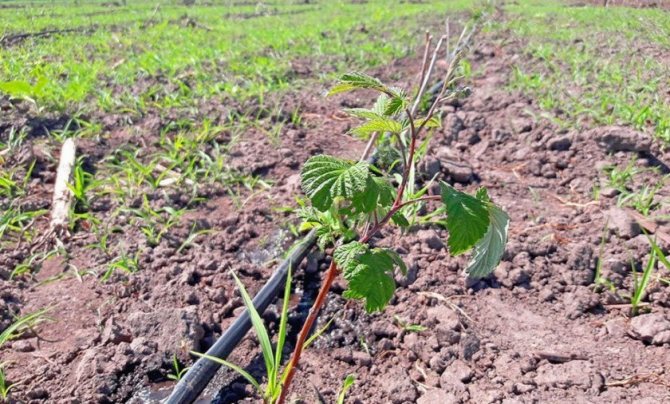

You also need to feed the logan berry correctly, as excess fertilizer can do more harm than good. The plant needs nutrients primarily at the stage of intensive growth and during the fruiting period. The first time the shrubs are fertilized when flowering ends, for this they use nitrogen-containing and phosphorus fertilizers.


Best suited for this is an infusion of cow dung (the ratio of manure to water per 1 bush is 1: 6) with the addition of 50 g of superphosphate. This feeding is repeated 2 more times: when the first fruits appear and before harvesting the ripe crop. In addition, 5 kg of compost is placed under each bush once every 2-3 years.
The attractiveness of growing a crop
These luxurious shrubs with dark berries are not so frequent inhabitants of our homesteads. Which is very sad. Since the culture pleases not only with amazing decorative qualities, but also with a richer harvest than raspberry varieties with classic shades of berries.
The early-ripening variety of black raspberries - Cumberland, is famous among Russian gardeners. This culture is native to North America, the Rosaceae family is a perennial. Its stems can grow up to 3 meters in length, differ in an arched shape, equipped with sharp thorns. Lush bushes with thorns and black fruits are of no interest to birds. Which is also an indisputable advantage in growing this crop.
Black raspberries have many similarities to blackberries. Their berries are very similar. Therefore, in another way, black raspberries are called black raspberries. However, you can distinguish one shrub from the second. In raspberries, it is not difficult to separate the berry from the stalk. Whereas in a blackberry it is possible to pick it only together with a receptacle.
The Cumberland variety attracts with the fact that it does not form root shoots. Therefore, the care of the culture is greatly facilitated. At the same time, the variety has an excellent yield.
Not only the fruits, but also the bushes of Cumberland are outwardly confused with blackberries. However, the variety is recognized by the following essential characteristics and features:
- the black raspberry variety has powerful (up to 3 cm thick) and elongating shoots (capable of growing up to 3.5 meters);
- the variety is resistant to diseases and pests;
- the plant is frost-resistant (it can withstand even severe frosts);
- excellent fruiting for 12-14 years;
- berries have a blackberry aroma;
- no root growth.
Despite the differences, the similarities between blackberries and raspberries are surprising. Especially when it comes to leaving. For example, autumn processing and pruning of blackberries and raspberries must be carried out without fail.
Varieties of garden ezhemalina with photo
Today, ezemalina is a berry, which has many varieties that differ in the qualities of bushes, sizes, taste of berries, etc. It is worth considering some of the varieties in order to better understand the question of what constitutes ezemalina.
Tayberry
This variety was bred by breeders not so long ago.Its main characteristic is its excellent yield. The plants themselves are quite thorny, and the berries have a dark red tint, large in size.
Loganberry
Feature - the absence of thorns and creeping branches, like a blackberry. The berries are red in color, but when ripe they darken significantly. One piece can weigh up to 5 g and reach more than 3.5 cm in length. Sourness is also present in the taste, ripening occurs early.
Boysenberry
This variety is also characterized by creeping bushes. The variety represents different plant forms - thornless and thornless. The berries are oval in shape, large enough, brownish in color. Their taste is closer to blackberries than to raspberries.
Texas
This variety is characterized by very large berries - up to 12 g in weight. They are elongated. The bush grows up to 5 m, but it does not stretch in height, but spreads. The plant tolerates frost well, especially when compared to other varieties. There are thorns on the bushes. The berries are more like raspberries, their taste is sweetish with sourness.
Darrow
And this variety is already growing upward, reaching 3 m in length. It tolerates frost perfectly, has thorns. From a sufficiently mature plant, about 5 years old, up to 10 kg of the crop can be removed. Sweet and sour berries are medium in size, weighing up to 4 g.
The nuances of cultivation and care
If you correctly choose a site for planting bushes, then care and pruning of black raspberries will not cause any significant difficulties. The area should be well lit by the sun and have reliable wind protection.
This will eliminate damage from glaciation and minimize the drying out of the stems in winter. The roots of black raspberry are characterized by deep penetration into the earth's thickness - they do not reach the groundwater by 50 cm. Therefore, the culture is not demanding for the type of soil. But he does not disdain timely watering and dressing.
Despite the drought tolerance and insensitivity to pests, viral diseases can cause great harm to bushes. Therefore, it is not recommended to plant black raspberries where potatoes or tomatoes grew. It is better to plant it away from these places, and also remove it from red raspberries. Black raspberries have one property - the formation of strong lateral processes on one-year stems (up to a meter long). A considerable part of the harvest is concentrated on them. Black raspberries are propagated by apical cuttings or leaf cuttings.
Otherwise, caring for black raspberries is identical to red. Due to the strong development and thickening of the bushes, the seedlings are placed at a distance of 1 meter from each other. And since the stems reach 2 m in height or more, then a garter to the trellis will not be superfluous for them. Spring pruning of Cumberland raspberries is designed to shorten the lateral processes on the stems, on which up to 6 buds are stored.
Regular pruning of Cumberland black raspberries in the fall will make it possible to create an excellent decoration of a summer cottage from seedlings, like a hedge. For which it is necessary to fix the stems on the sunny wall of the house or on the fence. In another case, in order to relieve the load from the branches, a wire support is designed. For this, wooden columns are installed at the edges of the row (2 - 2.5 meters high). A strong wire is attached to them at three levels - 0.5, 1.8 and 2.1 meters.
Types of black raspberry pruning
It is highly undesirable to neglect such a procedure as pruning the jemaline. If you forget about it, then the bush will thicken, which will affect the yield in the next season.
There are several types of this procedure. Each one depends on the chosen season and the tasks facing the gardener. Blackberry-like raspberries can be cut up to two times a year. This is usually done in the summer (pruning black raspberries after harvesting) and at the end of autumn when the air temperature drops to minus marks. It is possible to perform the procedure in the spring.
In the process of summer pruning, carried out after fruiting, the apical part of the stems is removed, leaving the bottom part of 1.7 meters. These manipulations should ensure the accelerated development of young shoots. The number of the latter in this case can be 6-8 pieces.
Pruning ahead of frost
What does the pruning of black raspberries give in the fall before the arrival of cold weather? This procedure allows you to make thickets less often and get an abundance of berries next year. At the same time, they will retain their excellent taste characteristics and will be large. Planting and caring for black raspberries is not so difficult - pruning the bushes in this matter plays a key role. Indeed, it is thanks to this procedure that harmful insects are distracted from planting, and the appearance of unpleasant diseases is prevented. At the same time, young shoots acquire the necessary reserve of strength for wintering, which helps them not to die before the onset of heat.
Also, pruning of Cumberland raspberries in the fall is required to eliminate two-year shoots after the fruiting phase. The shoots of the first year retain up to 30-50 cm from the surface of the earth, removing excess length. An important point is the competent preparation of the bushes for winter. For this, the stems of black raspberries are fixed at the soil surface (not very low) using metal staples (or wire). It is not required to additionally cover the plants. Since the frost resistance of the variety allows it to tolerate well even the warmest winter under the snow cover.
Autumn care: preparing for winter
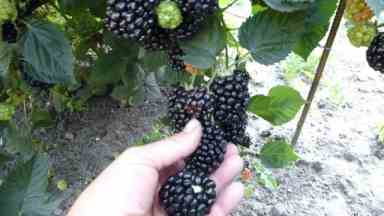

Some varieties of ezhemalina bear fruit almost to the very frost. Preparation for winter is carried out in late autumn. Remove old and dried shoots, excess and broken ones. The remaining branches are removed from the supports and covered. An important point is to have time to complete all procedures before the onset of frost.
An important point
Novice gardeners are often interested in how important pruning the Giant black raspberry in the fall is. And is it possible to do with the processing of raspberry bushes in the summer?
Experts assure that it is the autumn pruning and transplanting of blackberry raspberries before the first frost is the most optimal.
However, some gardeners practice stem pruning at the end of summer, when the last crop is harvested. As a result, the plants devote all their energy to the formation of new shoots. They are subsequently planned to be used as planting material.
Especially one should not wait for the arrival of late autumn in a situation with remontant raspberries. After all, pruning will not provide special benefits. But diseases and insects will open up wide opportunities. Therefore, it is best to still start pruning when the last berries are collected. So that the raspberry tree does not overgrow too much, the shoots should be left as long as they can then be removed.
It is good to leave enough space between the bushes. This will provide better access to the sun's rays and good air circulation. At the same time, the berries will grow rapidly and acquire an excellent taste. With these tips, novice gardeners will be able to quickly master the procedure for pruning black raspberries. The main thing to know is what, when and why to do it. A bountiful harvest!
Few have probably come across the name of ezhemalin, and therefore most readers may have a question about what kind of berry it is and what are its properties and cultivation features. In this article, you can find a detailed description of this unusual garden hybrid and agricultural technology for caring for it.
Testimonials
Tayberry has been growing for 5 years already. I like the taste very much, so this culture is the queen of my garden. A few words about agricultural technology. After reading the literature on growing raspberries and blackberries, I decided to pick off the tops of the shoots to stimulate lateral branching and increase yields. Conducted an experiment - I cut off one row, did not touch the second.Based on the results, I want to say that this technique only hurts every day. Its branching is already very active, as a result of lateral branches, almost the same amount will turn out, but we limit the length of the shoots, as a result of which the fruits become smaller. I also want to share my observations about watering. If you actively water raspberries during fruiting, then the berries become watery and the sugar content decreases sharply. It is necessary to water the ezemalina during flowering and while the berries are just forming and green, then let them "reach" themselves. Also, do not leave many shoots on each bush in the spring, I leave 4-5 branches. This is enough for the berries to be large and the overall yield is high.
Planted Tayberry as an ornamental plant. It looks gorgeous during fruiting - the leaves do not cover the fruits, as a result, a multi-colored bush of cherry, bright burgundy and even green berries is obtained. The vine is very flexible, it is easy to form a shape, I wrap around the southern part of the arbor. What is bad - the berries are baked in the sun, therefore, if grown specifically for the consumption of fruits, and not as an ornamental shrub, then it is worth planting in the shade.
Not much of a hassle with the Tayberry Yemalina. Experienced gardeners recommend a life hack to preserve the crop from birds - to cover the bushes with a mesh with a fine mesh (at the same time, additional protection of the berries from the sun's rays occurs). An unpretentious and fruitful hybrid will give tasty and aromatic berries for the preparation of winter preparations and fresh consumption.
Selection history, description, properties
The origin of this berry culture has a rather interesting history: in one of the American towns of the state of California, in the garden of a local judge named Logan, two berry bushes of raspberry and blackberry were accidentally crossed. This resulted in a crop of attractive large berries with a sweet taste, the popularity of which led to the further cultivation of the new crop, and the berries have since sometimes been found under the name "Logan".
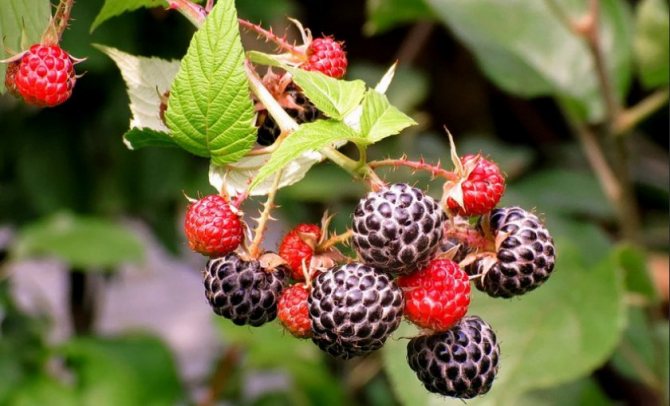

- The distinctive features of ezhemalina are:
- large berry size;
- the crop brings stable high yields;
- deep and powerful root system of bushes;
- the hybrid does not require special care;
- most varieties are highly resistant to diseases and pests;
- has good frost resistance;
- repair garden culture.
Ezhemalina grows in bunches, which provides high yields in a small area of the garden. However, the plants require shaping and garters as the branches of the shrub may not support the weight of the crop.
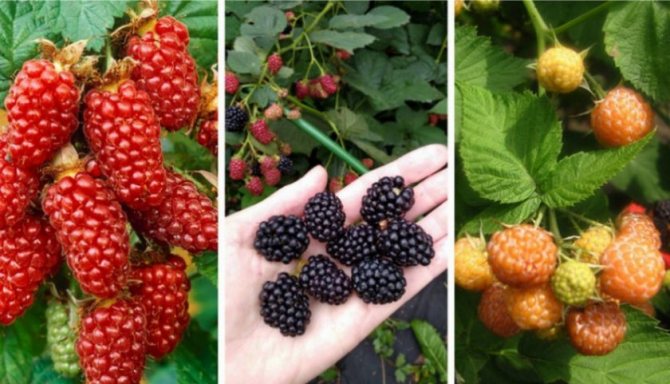

The berries can be red, black and yellow. Berries with different colors can grow on the same bush, which looks very interesting and attractive.
The bush can be planted and used as a hedge or an element of landscape design, since it has an attractive appearance, the plantings of jemalina are very thickened. Plants of various varieties can have thorny thorns, like, for example, Loganberry, but the Tiberi variety is characterized by their absence.


However, the use of berries for treatment should take into account the fact that berry juice cannot be taken by people with high acidity, suffering from gastritis, stomach ulcers.
- Also, contraindications include:
- urolithiasis;
- pathological kidney disease;
- gout;
- diabetes;
- bronchial asthma;
- polyps in the sinus;
- tendency to allergic reactions;
- pregnancy.
Features of a hybrid of raspberries and blackberries - ezhemalins
Ezhemalina is a berry shrub obtained by crossing raspberries and blackberries... Such a hybrid is usually very hardy, resistant and has good quality characteristics of the fruit. Depending on which of the maternal constituents prevails in the plant, the properties of the berries can change in one direction or another.
Differences from raspberries
In order to evaluate the properties of a hybrid, it is important to understand how it differs from the original crops.
So, unlike raspberries, logan berries are characterized by:
- typical burgundy or bluish shade of fruit;
- denser skin structure of berries;
- longer fruiting period (up to 10 years, while in raspberries - only 3-4 years);
- the structure of the bush: ezhemalina looks like a weaving bush;
- the berries of the hybrid are much larger (about 5 cm in length, in raspberries - up to 3 cm);
- high yield (up to 2.5 kg of berries from 1 bush, while from raspberry - no more than 300 g).


Differences from blackberries
Blackberries gave this hybrid the main positive characteristics, however, here, too, there are certain features due to selection:
- blackberry berries are painted in a pronounced black color, while jemalina fruits can vary in shade from dark red to blue-black;
- the hybrid has a deeper root system, which makes it much more drought tolerant than the parent shrub;
- the structure of the ezhemalina bush combines the features of raspberry and blackberry: at the base, the branches grow straight up, and then are located parallel to the ground.
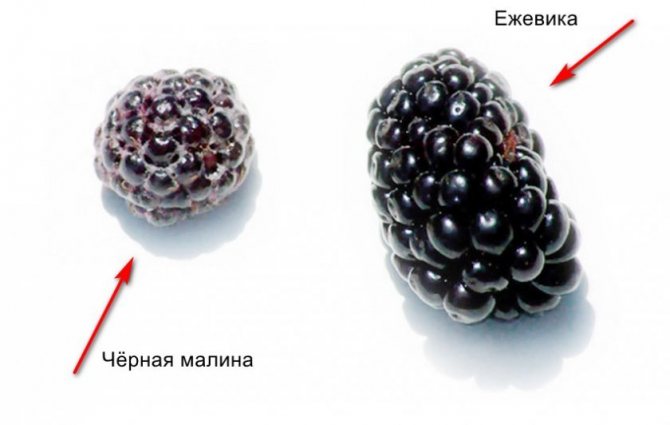

Specificity of care
Planting a culture occurs by rooting annual non-woody shoots or horizontal planting of seedlings, in the future, a trellis is required for its cultivation, since, like raspberries, many shoots appear on the bushes in summer. The hybrid can produce shoots from 2–4 m long, which are tied to a trellis as it grows.
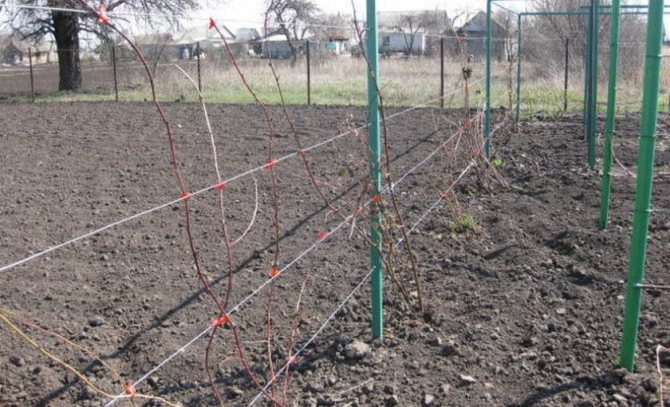

Experts recommend the trellis method of growing jemalberries, as it avoids thickening of the bushes, which can lead to a decrease in the size of the berries.
The tops, when they reach 2–2.5 cm in length, must be pinched, which will contribute to their thickening and ripening, and will also stimulate the growth of lateral shoots. It is necessary to feed the bushes at the end of spring. To do this, you can use urea, infusions of manure and mullein, with the addition of superphosphate and ash, which are allowed to be used after the first season of fruiting.
- sawdust;
- straw;
- dry grass;
- manure or peat.
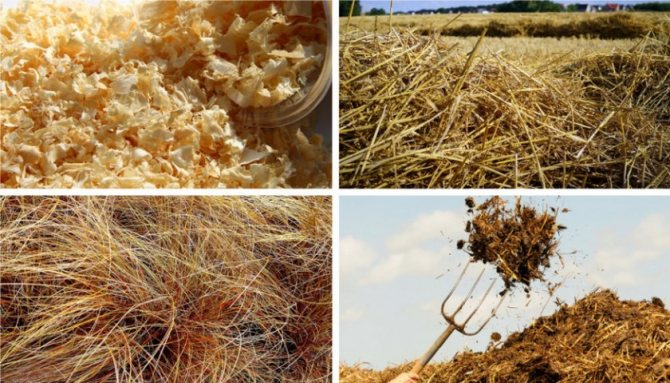

It is necessary to water the bushes with a large amount of water during the period of active ripening of the berries, which will allow you to grow a crop with large fruits. However, the condition of the soil should be monitored and moisture stagnant should not be allowed, therefore it is rational to use the drip irrigation method. In winter, it is required to remove the shoots from the trellis and bend them to the ground, and in the spring they are lifted and returned to the support, making sanitary pruning. If there is a sufficient amount of precipitation in the region in winter, then the branches can not be covered.
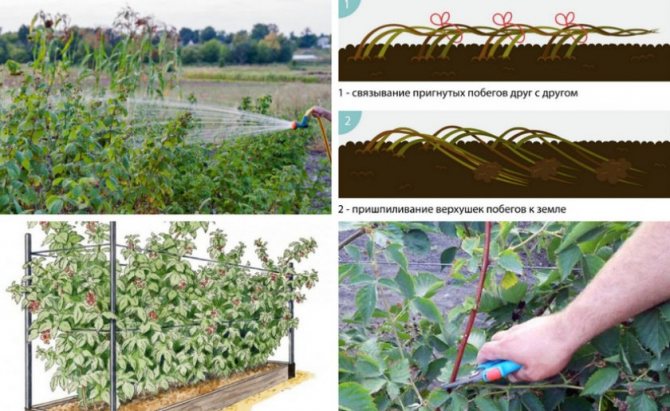

Diseases and pests
Implementation of agricultural technology, proper care will save you from diseases and parasites. Let's analyze the probable problems.
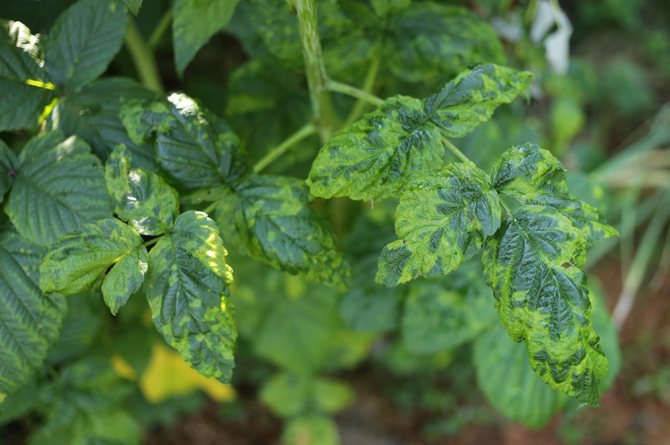

Diseases:
- Anthracnose: branches are covered with brown heels, which has the ability to completely spoil the culture. In order to prevent this from happening, do not thicken the plantings, constantly prune. Carefully cut and destroy infected branches. Treat with foundation or topsin. For prophylaxis in the spring, treat with a 1% solution of Bordeaux liquid, repeat the operation after 10-12 days.
- Gray mold: fruits and leaves are covered with a whitish bloom. It is possible to use the treatment with a fungicidal substance 20-30 days before harvesting. Follow the instructions exactly (do not exceed either dose or concentration). It is possible to make processing with a decoction of horsetail or nettle. It is allowed to use 1 of the following solutions (per 10 liters of water): 200 g of ash; 1 kg of manure; 100 colloidal sulfur; 50 g of soda ash.
Among the pests, they have every chance of disturbing: crimson beetle, weevil, galitsa.
Protective measures:
- The deepest autumn digging is carried out from the larvae of the raspberry beetle.
- During the development of the buds, process the infusion of tansy (for 5 liters of water you need 1 kg of fresh or 350 g of dried tansy, boil for 30 minutes, leave for a day, then strain and add 5 liters of cold water.
- Treat with karbofos during the budding period.
- Cut and burn wilted tops every 2 weeks.
Formation of bushes: procedure algorithm
The formation of the ezmalina consists in its pruning. There are several theories as to when this procedure should be performed:
- in spring, before the start of active growing season;
- in the fall, at the end of fruiting.
- during pruning it is necessary to remove old, damaged, dried branches.


Also, pruning is done after planting the seedling, when its top is cut off by 25-30 cm.
How to prune properly for a good harvest
In order to increase yields, the formation of a bush should occur annually, the number of correctly pruned pruning should be at least two. So, the procedure should be carried out regularly:
- when spring comes;
- when autumn comes.
In the fall, at the end of the harvest, it is necessary to cut off two-year-old shoots, which have already completed fruiting, at the root, and one-year ones are shortened to a height of 50 cm. Only 8-9 strong and strong stems are left for wintering, and all the rest are cut out completely.
Video: How to crop a zemaline.
Seasonal features
With the arrival of warmth, when the frosty weather has already receded, caring for the ezemalina involves sanitary pruning of branches deformed after wintering. Summer pruning involves shortening the shoots at the growing point to increase the yield of the bush.
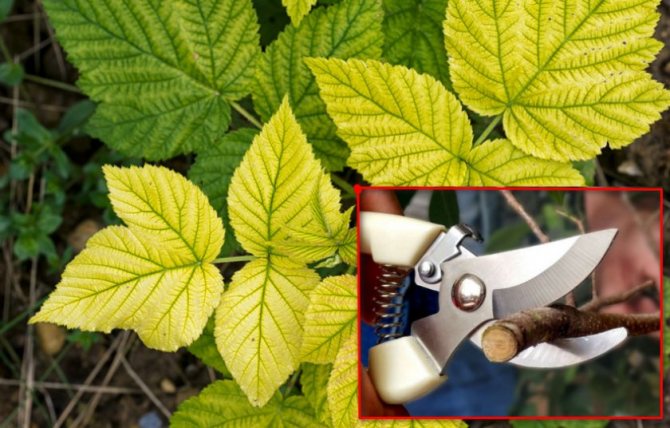

The autumn formation of the bush is carried out to prepare the plant for the onset of cold weather and reduce its trauma, for which the fertile and deformed stems are removed.
Garter bushes
Since ezemalina has the ability to grow rapidly and the stems of some of its varieties can reach 4 m in length and 25 mm in thickness, it is recommended to grow the plant on a trellis, gradually tying up powerful branches as they grow.
It is recommended to use a flat trellis with a height of 2–2.5 m. To do this, you can use vertical supports, between which 3-4 wires are pulled at different heights. Fruiting stems are attached to the upper tiers of the trellis in the form of a snake, the rest of the stems are attached to the lower wire.
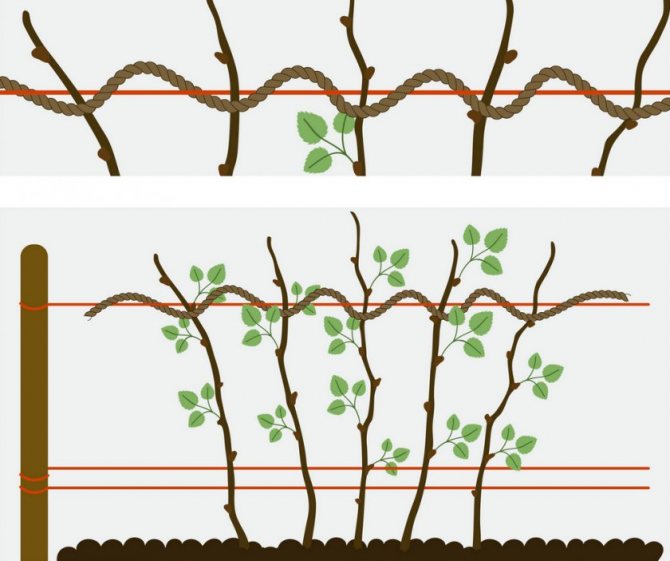

In the process of ripening on a trellis, the berries receive a sufficient amount of solar heat and have good air access.
Care after pruning
Experts recommend pinching the shoots after pruning. At the end of the procedure for the formation of the ezhemalin bush after the completion of fruiting, the branches must be removed from the trellis. They are carefully folded along the trellises, trying not to injure the stems. As a shelter for the winter, you can use:
- peat;
- sawdust;
- fallen leaves;
- straw;
- corrugated board or used cardboard boxes.
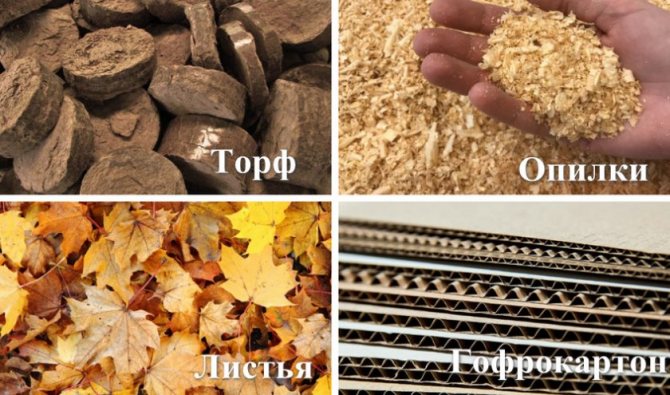

Caring for ezemalina practically does not differ from caring for other horticultural crops. The hybrid is very fertile and pleases with an abundant harvest of large and sweet berries.

